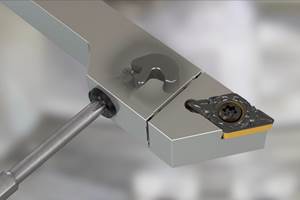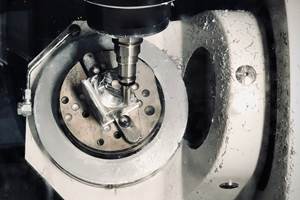Investment In 'Horizontals' Pays Off For Parts Manufacturer
Precision parts manufacturer Quality Machining Inc.--QMI--supplies high-precision machined components each year for companies such as Caterpillar, Dana, and Kraft. While much of QMI's work has centered around bar turning, the company has recently charged into the machining center arena, in order to handle growing opportunities for complete prototype to production machining. To enable the company to do this, it decided to buy horizontal spindle machines.
Share






Precision parts manufacturer Quality Machining Inc.—QMI—(Waunakee, Wisconsin) supplies high-precision machined components each year for companies such as Caterpillar, Dana, and Kraft. While much of QMI's work has centered around bar turning, the company has recently charged into the machining center arena, in order to handle growing opportunities for complete "prototype to production" machining. To enable the company to do this, it decided to buy horizontal spindle machines.
The company's first foray into the world of horizontal machining ended badly, according to John Pasinato, general manager. "We were expecting great things from the first two horizontals we purchased, but we did a time study and the machines just didn't meet the cycle times quoted so we took `em out the next day," he says.
Then QMI looked into Niigata (a division of SNK America, Rolling Meadows, Illinois) and bought three SPN Series Niigata horizontal-spindle machining centers. The company bought its first SPN 40—with a 400 mm pallet size, 1,575 ipm traverse rate, 1.0 second tool-to-tool change time, and 7.0 second pallet change time—right off the floor at Westec '96. Its second SPN 40 soon followed, and it has just added the SPN 50 to increase the work size to 500 mm.
"We run the Niigatas practically non-stop 100 hours a week," Mr. Pasinato says. "The performance improvements we get versus our existing vertical-spindle machines is substantial."
For example, the new SPN 50 has cut cycle times on an important aluminum valve block requiring two holes on each of three sides from six minutes when done on a vertical, to just two minutes. When you multiply the four minute savings times thousands of parts, it adds up.
"We've reduced what used to require three separate setups (one for each side) to just one setup," says QMI process engineer Jeff Bunch. "Not only that, but we're only clamping up the part once rather than three times, helping us hold the tight tolerances the customer requires." Mr. Bunch also likes the fact that he can now "put more parts under the tool" at one time on the Niigata, fixturing four parts or more at a time and machining them all in a single setup.
Remove the protective enclosures that surround the SPNs and there is a machine design with several features. Most noticeable is the stationary column/traveling saddle. While most horizontal machines have a slower-moving, heavier traversing-column X-axis design, the SPN's traveling saddle is much lighter, delivering up to twice the X-axis traverse speeds and acceleration/deceleration rates. This translates into a significant reduction in non-cutting times.
Niigata also uses a synchronous swing motion tool change system that completes a tool change in one continuous smooth motion, compared with conventional designs requiring three or more motions. As a result, tool-to-tool time is as little as one second on the SPN 40s.
But specs and drawings alone can't tell you everything you need to know about a machine's performance. "Nice work envelopes, big open operator-friendly spaces, tools that can be accessed even when the machines are running, no blind spots, simple Fanuc controls—that's what we like about the Niigatas out here," says Ron Spahn, production manager.
Related Content
Orthopedic Event Discusses Manufacturing Strategies
At the seminar, representatives from multiple companies discussed strategies for making orthopedic devices accurately and efficiently.
Read MoreQuick-Change Tool Heads Reduce Setup on Swiss-Type Turning Centers
This new quick-change tooling system enables shops to get more production from their Swiss turning centers through reduced tool setup time and matches the performance of a solid tool.
Read MoreHow to Successfully Adopt Five-Axis Machining
While there are many changes to adopt when moving to five-axis, they all compliment the overall goal of better parts through less operations.
Read MoreHigh RPM Spindles: 5 Advantages for 5-axis CNC Machines
Explore five crucial ways equipping 5-axis CNC machines with Air Turbine Spindles® can achieve the speeds necessary to overcome manufacturing challenges.
Read MoreRead Next
Machine Shop MBA
Making Chips and Modern Machine Shop are teaming up for a new podcast series called Machine Shop MBA—designed to help manufacturers measure their success against the industry’s best. Through the lens of the Top Shops benchmarking program, the series explores the KPIs that set high-performing shops apart, from machine utilization and first-pass yield to employee engagement and revenue per employee.
Read MoreAMRs Are Moving Into Manufacturing: 4 Considerations for Implementation
AMRs can provide a flexible, easy-to-use automation platform so long as manufacturers choose a suitable task and prepare their facilities.
Read More



















